Human Flower Project
Tonic to the Nation
Did you miss the Festival of Britain? Likely so. And though post-war styles are in revival, its spirit of communitarian hope is harder to come by.
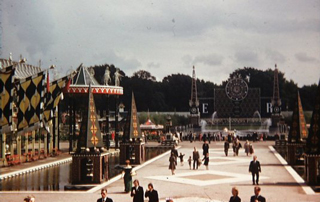
Festival Gardens at the Festival of Britain 1951
Let the days of “getting-by” be gone
Photo: Pete G., via wiki
By John Levett
One of the most memorable events in my life was the 1951 Festival of Britain—memorable because I never went to it. I was six years old at the time and most probably was completely unaware of its happening then, but as the years and decades went by it loomed larger and larger in my consciousness as one of the significant misses in my life. The most probable reason for the miss was that my mother couldn’t afford it. She ran a small grocer’s store in Luton at the time and looked after gran. I doubt that the store made much but it was the only grocer’s in the street so we got by.
‘Getting by’ was a frequently-used phrase in the post-war years. One of the finest writers of social history of this or any time is David Kynaston. Last summer I read his opening volume of Britain’s post-war years ‘Austerity Britain 1945-51’ and am just finishing ‘Family Britain 1951-57.’ No description of their quality from me would suffice; read them and smell the smog.
Earlier this Summer I was frequently trolling down to London with packages of art work for a couple of exhibitions tied to bike, thence to backpack. For this annual hike I have a carrier-bag of string; for the packaging I have bubble-wrap from the waste-skips at the back of a retail park; for the reinforcement I have cardboard from the back end of Asda. I’ve never outgrown the collect-and-save “You’ll never know when it’ll come in useful” routine of those post-war years; never walk past a builder’s skip without checking if there’s anything worth retrieving.
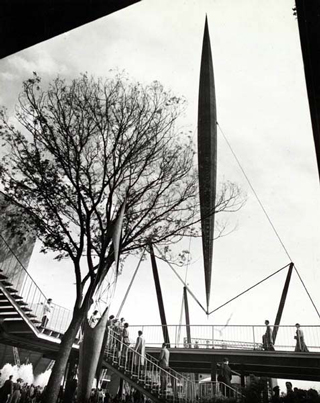 The Skylon tower
The Skylon tower
at Festival of Britain, 1951
Photo: Museum of London, via wiki
The Festival of Britain was seen as a symbolic end to all that making-do and awaiting stuff to make-do with. It was conceived by Herbert Morrison of Britain’s post-war Labour government, initially as a centenary commemoration of the Great Exhibition of 1851 but actually a visionary call to point a way forward and inspire a regeneration of design and manufacture at a moment when post-war revival appeared to be flagging. ‘A Tonic to the Nation’—such it was called.
The Conservative opposition, then led by Churchill, hated it—wasteful, irrelevant, propagandist, Soviet-style preening. It was built on a bombed site on the South Bank and represented to the people (or should that be the People) that things didn’t have to be like they’d always been. Truth to tell, most British households went through the rest of the fifties doing and living just what their parents had done and lived in in the thirties and forties, and in many parts of Britain the poverty and malaise remained. David Kynaston: “1950s Britain was also an authoritarian, illiberal, puritanical society.” Some things changed; much didn’t.
Not getting to the Festival, however, gave to its held-out possibilities a continuing & enhanced quality that grew over the years. In the early ‘70s I acquired an archive of printed material from the Festival — catalogues, postcards, promotional materials, magazines, programmes and so forth. Every so often I’d take out the archive, spread it out and sit looking at it, picking up the odd piece and scanning through. The pool of items seemed to me to represent a moment that held so much and which so swiftly passed—not in terms of design, construction, use of space, city layout, personal comfort, communication, education, artistic creation but in terms of a communal future. Perhaps it was the promise of that that prompted the Conservative government that came to power shortly after the Festival’s closure to remove every vestige of it bar one: the still-standing Festival Hall.
During this summer there has been a running commemoration of the Festival on the Southbank—the sixtieth anniversary. I briefly reflected on the representation of our current global attention span that anniversaries used to be of the magnitude of twenty-five, fifty and one hundred years. Now it’s annual, five, ten, fifteen & so forth. With each commemoration the communal myths grow; the history becomes more of a fairytale.
The Southbank has now become a major site of cultural elevation—the Festival Hall augmented by the National Theatre, the Museum of the Moving Image, the National Film Theatre, the Hayward Gallery, the Queen Elizabeth Hall and the Purcell Room; bijou coffee bars by the dozen; boutique eateries; happy-clappy jug bands; skateboard underpasses (whose users illustrate that we’re still crap at that). The whole atmosphere is all very family-friendly which, being without family, is no recommendation and having to suffer other people’s kids is a frequent piss-off. Exit Micawber stage right.

Roof Garden constructed for the 60th anniversary of the Festival
Photo: John Levett
Enough of that. A feature of the recent hoopla was the constructed garden on the roof of the Queen Elizabeth Hall. I’ve always had doubts about the make-a-garden-in-an-old-boot trend that’s arisen over the last decade or more. I think it started at the same time as the drive to getting a ‘water feature’ into every suburban plot. Everyone with a bit of nouse and eyes knows that anything to do with water in open air needs 24-7 maintenance lest it becomes home to planet-devouring new forms of life last seen in fifties flicks. So with the ‘old boot’ garden. If you’re dedicated to this form of gardening then you’ll survive even if it doesn’t turn out like it shows in the garden book. (Don’t be fooled by the garden book photo. Some of those things are shot with equipment it takes a bank to finance.)
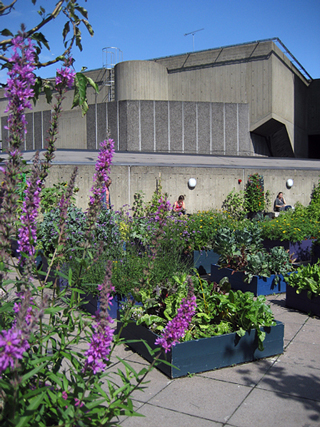 The Roof Garden, a collaboration of the Eden Project and Providence Row
The Roof Garden, a collaboration of the Eden Project and Providence Row
Photo: John Levett
The garden idea came from those associated with the Eden Project and was brought to actuality by the long-established Providence Row project, which addresses homelessness. The garden is of raised beds on concrete. I’m never sure of how these work over time and how much maintenance they need. I’m unsure about the economics of the projects, too. I’ve a neighbour who has a number of these things made from old railway sleepers in which she grows peppers, marrows, onions, tomatoes, cucumbers and various herbs. She’s retired so she sticks at it most days and seems to get by with an annual replenishment of topsoil. I think she follows the only rule of gardening that truly works—small bits, no blitz.
Since the crash, there have been frequent articles in the Sunday supplements about Grow Your Own and how to cut down on the grocery bill. These are mostly foolish. The cost of growing your own eating is close to the phenomenal. The only benefit is the (broadly and liberally defined) spiritual, ethical and the physical in which what you grow is less important than the process of growing. My mum and I had an allotment in the ‘70s and after a couple of seasons of potatoes, onions and artichokes we decided that what we’d really prefer is sweet peas so we put up the poles and stuck with those.
I was at a meeting last year in which I was asked if I thought that I’d made any mistakes in organising a particular project, to which I replied that I never make mistakes. This, I decided, was a good attitude of mind unless I was in charge of a nuclear arsenal. I have the same attitude regarding gardening—try it and see if it works and if it doesn’t then nobody dies. The garden that I now have has to change at some time if I keep going on going on. The thing is that every time Spring comes around I always think that it’ll be good for a few seasons more.
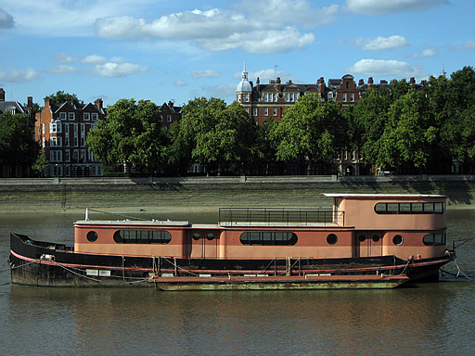
On the Thames at Battersea Park
Photo: John Levett
The walk around the roof garden I took on one of the few days of true Summer and decided to carry it on to Battersea Park. The park was the site of the Festival Pleasure Gardens in 1951, beside the river. The embankment this time of year is as packed as a football match so I took the backways as far as the old power station. This part of the river going towards Hammersmith is Gulley Jimson territory and on days like this, living on a house boat seemed a worthy aspiration; by this time I was flaking. I got as far as the ice-cream parlour. I sat in front of the peace pagoda and reflected.
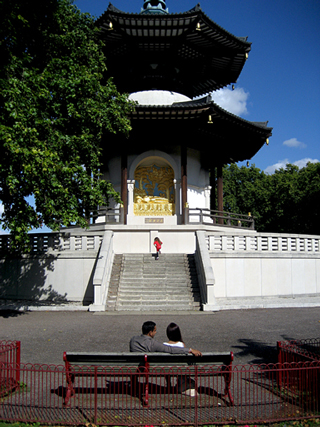 The pagoda at Battersea Park
The pagoda at Battersea Park
Photo: John Levett
When it was first proposed I think the Festival represented a view of our future that would be, to a significant degree, communal; that matters of production, distribution and our societal exchanges would be a matter for our communities; that the imperialist and capitalist rivalries of the half-century that had just passed would be replaced by a a broader view of popular engagement in the political and economic spheres supported by a sustainable improvement in the conditions of living and creativity.
When the Festival opened, the Korean War was a year old. The Festival represented what would now be called, a ‘narrative’—somebody’s idea of how things are and how we would like them to be. I reflected that I still carry that narrative with me. I also reflected that I’d got a two-hour meeting to go to and it’s rush hour.

